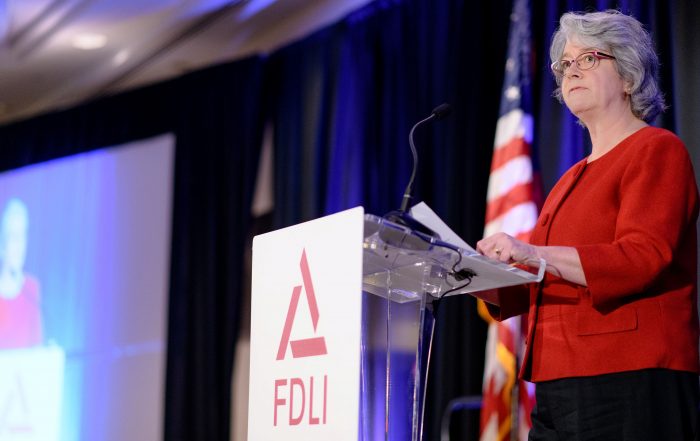Inaugural Eric M. Blumberg Memorial Lecture
December 13, 2013

Good afternoon. For those of you who do not know me, my name is Annamarie Kempic. I am the litigation deputy at the Food and Drug Administration’s (FDA) Office of the Chief Counsel. For those of you who knew Rick Blumberg, I was his deputy for 12 years and worked with him for the past 25 years and became his co-deputy just a few days before he died.
Rick spoke at this conference for the past few years and I must tell you that he would be thrilled at having this enforcement lecture established in his memory; the knowledge that his name and the word “enforcement” will continue to be linked each year in a presentation to all of you would give him great satisfaction – and some amusement. And you should know that I am committed, as is our superb litigation staff, to continuing Rick’s work. In fact, the topic I was asked to speak about, how enforcement affects the public health, is tailor made for Rick’s view of FDA enforcement, for he was known to introduce himself at meetings as the lawyer for the public.
Rick had a very clear understanding of his role and did not let himself be sidetracked as different compliance and enforcement initiatives came and went. He was FDA’s lawyer, true, but he viewed himself first and foremost as the advocate for the public, that is, the people who rely on the products you make and FDA regulates. He saw his – and FDA’s – role as a critical “behind the scenes” presence to act in the public’s interest.
How does this work? Rick would often use the following example in talks on this subject; Chester Bowles, the head of the office of price administration during World War II, would say that in any given industry, 20% will comply no matter what, because of the values and philosophies of those in charge, 20 % will not comply no matter what (these are the folks who try to continue illegal activities from their prison cells), while the final 60% watch to see what happens to the non-compliant 20% and modify their actions accordingly. Now the actual numbers will likely vary across industries and with changing circumstances, but the general categories ring true. Our goal is to convince as many of you as possible in that 60% to join the compliant 20%. There is no mystery here: as the law enforcement community knows, certain, predictable and deliberate enforcement is a great motivator.
And given the numbers and types of products FDA regulates; the public has a great stake in the compliance decisions each of you or your companies or employees or clients make every day. Remember that FDA regulates everything from dog food to complex surgical devices and everything in between, it is frequently noted that the agency regulates products accounting for 25 cents of every consumer dollar spent in the us; the public has an enormous stake in being able to rely on your products, both the right to expect them to do what they say they will do, in the case of medical products, or at a bare minimum, to ensure that they do no harm. In other words, foods and medical products are critical to the public health as they, in the words of the supreme court, “touch phases of the lives and health of people which, in the circumstances of modern industrialism, are largely beyond self-protection.” There is a reason caveat emptor – or buyer beware – is not the standard assumption for these products.
That is where FDA plays the vital role of, in a very real sense, being the eyes and ears for each consumer who cannot know or control the production of the products which can change their lives. So FDA’s role is to ensure that those of you in Chester Bowles’ 60% are motivated to make sure that your operations comply with the law. And make no mistake; we know that those of you in the 20% who comply are self-motivated, so this talk is not directed at you. Enforcement is geared toward “motivating” those in the 60%. Motivation can occur in any number of ways, through the various FDA enforcement tools.
FDA’s enforcement fall into three general forms, all of which have public health implications. There is some overlap in the outcomes and nature of these actions, so my descriptive categories are just that; a convenient way to focus on the results that the agency tries to achieve rather than legal descriptions of the statutory provisions, so don’t read any more than that into the organizational structure of my talk.
First, the agency may initiate action to keep products out of interstate commerce; this minimizes or prevents consumer exposure to illegal and often dangerous products. Second, the agency may initiate a case to ask the court to stop illegal activity and/or compel compliance with the law. Third, the agency may seek to send a message that certain behavior or activity is unacceptable and will not be tolerated, either through civil money penalties or a prosecution. The criminal cases serve to deter future violations and seek, on the public’s behalf to punish the perpetrators. I will talk about each of these goals and the way the agency sets about to accomplish them.
FDA enforcement is geared toward correcting the violation of the law and making sure consumers are not exposed to illegal and potentially unsafe products and compelling compliance on the part of the defendant and – hopefully — inspiring other similarly situated parties to take the actions necessary to correct their violations so that they are not the next defendant.
In the first category, the agency concentrates its efforts on keeping violative products out of commerce. Many of you are aware of, or at least have heard of, in rem seizures in which theUSmarshal, in response to FDA’s request and a court warrant, seizes products that FDA alleges violate the law; the goal being either to bring the products into compliance or to have them destroyed. Over the past several years FDA initiated seizures over everything from foods in filth infested warehouses to pet foods, foods containing chemicals or drugs, dietary supplements with unidentified and sometimes dangerous ingredients, unapproved drugs, and medical devices ranging from latex gloves to surgical instruments and surgical implants. In these cases, the agency acts to protect the public from products that can be harmful, ineffective, or purely fraudulent. And the concerns in the latter two categories include consumers being diverted from therapies that actually work to intervening so that consumers are not unwittingly in a situation in which they are simply throwing away their money because of fraudulent product claims.
Some of the more memorable seizure actions from the past several years, which illustrate this point and the impact of the agency’s use of this tool, include a seizure of shelhigh’s implantable devices. These products were used in heart, neurological, and abdominal and thoracic surgery including procedures on infants. And a footnote here, this is the last case that Rick personally handled to a major extent. The company used unknown and dubious procedures to prepare the implants and the facility was in disarray to the point that a worn and filthy broom was propped along the wall in the so-called clean room; there was no air control in the facility used to prepare the presumably sterile implants and the company failed to monitor the manufacturing environment for microbial contamination. In fact, the company had a history of sterility test failures. The seizure kept the products from being implanted into additional patients.
And make no mistake that the public realizes it has a stake in the products FDA regulates. Some of the strongest and most positive and enthusiastic feedback FDA received from the public, in my experience, followed the FDA-initiated seizure of a large Petco warehouse filled with filthy, vermin infested pet food. The agency then worked to supervise the company’s clean-up.
Likewise, FDA now has administrative detention authority over foods, drugs, devices, and tobacco. This means that product that appears to be in violation of the FDA can be detained during an inspection to prevent its distribution while the agency works to initiate federal court proceedings. Recalls pull violative and often dangerous products off the shelves and import alerts and detentions serve consumers by keeping illegal and in many cases harmful products out of commerce. In each of these actions, the agency intervenes to shield the public from unwittingly using and being exposed to illegal, sometimes fraudulent, and frequently harmful products.
When a more enduring result, that is, a comprehensive fix is needed, when, for example, there is a system in place that continues to churn out illegal, unapproved, or contaminated products, the agency will seek other types of relief to either stop the violations, compel compliance, or both, through a court order. Injunctions, license suspension of food facilities, or debarment for drugs and some food importation are some of the more typical actions that achieve these goals.
For instance, the agency initiated injunction proceedings against chung’s, a major seafood egg roll manufacturer, and its responsible officials because of insanitary conditions and lack of controls for dangerous contaminants such as clostridium botulinum in its manufacturing operations. The district court in texas issued a lengthy opinion, granting the injunction and resisted any suggestion that food safety obligations should be passed off to consumers, recognizing that “the burden of food safety…is squarely on food manufactures.” The court adopted a bedrock principle of FDA/consumer protection law in noting that the supreme court recognized that obligations are imposed on those who manufacture regulated products and have at least the opportunity to inform themselves of “the existence of conditions imposed for the protection of consumers before sharing in illicit commerce” rather then foisting the risk onto the unsuspecting public.
The agency intervened when data integrity issues, among other manufacturing violations, surfaced regarding product from a ranbaxy facility in india, along with some particular products that were out of specification or didn’t meet stability standards. The agency obtained a consent decree of injunction to set out a controlled process to ensure that the data integrity and other violations were corrected. And to keep the product out of the US markets until those corrections are completed and to add incentive, in the form of potential liquidated damages, for thorough and sustained corrections. The decree also required a critical third party assessment of data submitted to the agency in support of other drugs and the potential withdrawal of any application found to contain untrue statements and/or a pattern of data irregularities. There was also a criminal resolution against Ranbaxy which I will discuss in a minute, but the message here should be clear. The agency takes data integrity very seriously; it is the foundation for product integrity and approval decisions and FDA can and will use all of the tools at its disposal in those instances in which it finds that data integrity has been compromised.
The agency also has new tools at its disposal including the suspension of food facility registration in the event of an associated outbreak of food borne illness. Late last year, the agency invoked this provision to suspend the registration of a peanut manufacturing and processing facility. For those of you not familiar with this provision, FDA may invoke it when food in a facility has a reasonable probability of causing serious injury or death and the facility knew of or caused the reasonable probability. The suspension, which acts to halt all food distribution from the firm, continues until the agency is satisfied that adequate corrections have been made. In this case, the peanut butter was identified as a the likely source of a multi-state salmonella outbreak and the suspension was in place until it was replaced by a consent decree of injunction to address the various phases of the company operation and the different remediation efforts needed. In general, a suspension may be continued until the violations are corrected.
The agency can also institute debarment proceedings against companies or individuals following certain types of criminal convictions involving drugs or imported foods. Debarment is intended to protect the integrity of the drug approval and food importation processes by keeping out of those industries companies and individuals who, based on related criminal convictions, can’t be entrusted with the responsibilities in industries so core to the public well-being and health.
The third general result FDA seeks throug its enforcement is to take action to make clear that certain behavior is unacceptable and will not be tolerated and to seek a rememdy on the public’s behalf. This can include civil money penalty actions against certain products (devices or tobacco currently) and criminal prosecutions. And the latter, of course, are directed toward the goals of punishing those responsible for the violations, as well as deterring future violations by others in the industry.
The agency’s newest component, the center for tobacco products, has certainly been sending the message about prohibitions on tobacco sales to minors by initiating hundreds of civil money penalty actions. Likewise in a recent cmp action against advanced sterilization products, a division of ethicon, and two of its executives, the agency brought a civil money penalty action because the company shipped product, biological indicators used to monitor and confirm whether the sterilization in the company’s sterilizers is effective, even though they knew they did not have the data to support the labeled shelf life for the product. The total obtained in the case was $ 1.25 Million.
And certainly the criminal investigations and prosecutions support and further the message that those who are responsible for FDA regulated products will be held accountable for violations. This is a critical part of OCI and the rest of the agency’s enforcement strategy. As I said earlier, lives depend on these products and OCI and the rest of the agency have worked with DOJ to ensure that egregious violators, those responsible for jeopardizing the lives, health, and well-being of american consumers, will be prosecuted.
As I mentioned earlier, in addition to working to correct ranbaxy’s violations through a consent decree of injunction, the agency worked with DOJ to obtain criminal pleas and penalties. Ranbaxy had incomplete testing records, inadequate stability testing and, despite knowing that certain batches were testing out of specification, contained unknown impurities, and would not maintain their expected shelf live, did not timely inform FDA of these problems. In fact, ranbaxy continued to ship one drug to the usa even after it failed stability test. With respect to other drugs, ranbaxy conducted the stability test weeks or months after the date reported to FDA. Ranbaxy pled guilty to 3 felony violations of the federal food, drug, and cosmetic act and 4 felony counts of making material false statements to FDA. The company paid a criminal fine and forfeiture totaling $150 million.
The agency also pursued misdemeanor prosecutions against 4 executives of Synthes, a medical device manufacturer. Synthes shipped the devices at issue to treat vertebral compression fractures of the spine, in effect, conducting an unauthorized clinical trial with the knowledge that it was dangerous. They did not halt the distribution until 3 patients died. The executives were charged under the Park doctrine and pled to misdemeanors. They were sentenced to various periods of incarceration, ranging from 5 to 9 months. The court, in imposing the sentences, noted that meaningful terms of incarceration would serve as a deterrent to others in FDA-regulated industries and that their conduct demanded “swift and substantial punishment.”
The agency also recently worked with DOJ to prosecute two individuals responsible for introducing tainted cantaloupe into the market. According to the plea agreement, the equipment used to process the cantaloupes had been replaced and the systems intended to introduce chlorine cleaning system was not in use. The cantaloupe contained listeria monocytogenes. It was distributed widely in at least 28 states. According to CDC’s tracking, the contaminated cantaloupe caused at least 33 deaths, 147 hospitalizations, one miscarriage, and possibly ten additional deaths, all because of a food that most of us would not think twice about eating. Each individual pled guilty to 6 counts of causing adulatered food to be introduced into interstate commerce. Sentencing is pending. According to CDC estimates, food borne illnesses result in at least 48 million people in the US getting sick each year, 128,000 must be hospitalized, and 3000 die. Think about those numbers for a minute. Prosecutions make clear that there are consequences for failing to take the necessary care in food processing because of the unacceptable risk to the public.
So that is what FDA does. But the industry also has a role. If you want to avoid these types of actions, and the ancillary consequences to your business and employees, think hard about what you can do to ensure compliance. If you are in that middle 60%, I strongly encourage you to do everything in your power to pull yourself into the compliant 20%.
To give this concrete meaning from the consumers’ perspective, I would ask that you think of other FDA-regulated products than those with which you are familiar. Those of you in the device industry, think for a minute of what you know about food manufacturing; drug manufacturers, think about device manufacturing; food manufacturers about biologics. Think about how much you and your families are at the mercy of decisions made by others regarding products that can, in a very real sense cause a life or death outcome. Think about whether you want those in charge of those industries to take shortcuts, ignore or explain away consumer complaints about ineffective or unsafe products, or simply refuse to invest what is needed to control the manufacturing process. Think about your own part of the industry and how compliance with the law keeps the playing field level, and maintains consumer confidence in your products.
How do you do this?
Create and maintain a corporate culture that commits to compliance. My father managed a grocery store. When I first came to FDA, I asked him curiously, how the store dealt with pests when they got into the facility, presuming, based on what I was learning through the results of FDA inspections and hearing from defendants in the food industry, that there had to be a problem and he had just shielded me from this knowledge all of my life. He looked at me in amazement and said his store never had a pest control problem; not once in the 36 years he managed it. He ticked off all the precautions he instituted to prevent vermin access, and all the monitoring he made sure his employees conducted. His view was, one infestation is too many; he felt a strong commitment to his customers and the quality of the service he provided to them, he was determined that his customers could rely on the cleanliness and quality of the food he sold. Given what I was seeing and hearing through FDA from other parts of the industries, I was both amazed and proud of his answer. My father died earlier this year; and I was astounded at the number of his former employees who spoke to me during his funeral, to tell me that he never let them do second rate work and that cutting corners was out of the question. He always insisted on their best performance because his customers, the public, deserved no less. He often remarked that in his business, your reputation is everything and when word gets out that a company tolerates slipshod practices, your customers leave. And I encourage you to adopt a similar compliance philosophy.
Make certain that your front line employees feel free to note and intervene in compliance problems. And listen to them; if you don’t, these are often the folks to come to FDA with their concerns.
Take prompt and effective action to correct any violations. Designate a person to be responsible for compliance.
Ensure that all employees recognize the critical role they play in your company’s overall compliance and recognize and reward those who come forward with potential violations, as they are the key to both building a compliance culture, keeping your entire company out of legal trouble, and protecting the public.







